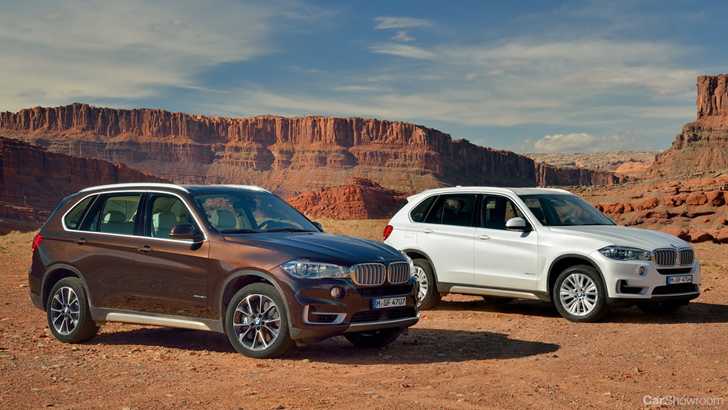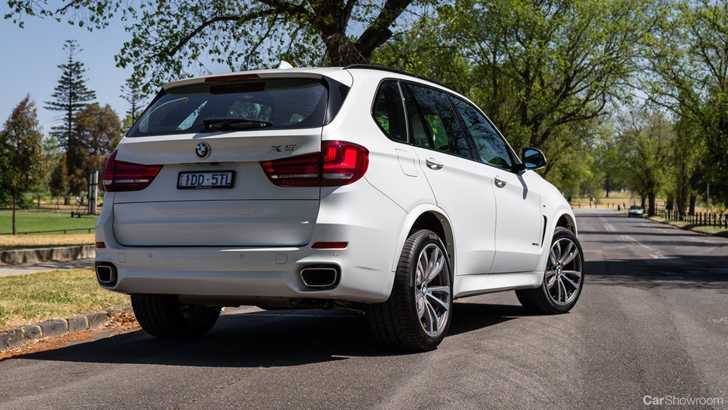Three generations on, the BMW X5 still stands strong.
The BMW X5 has, by and large, been the family wagon that most lust after. When it first came about in the year 2000, the only other real luxury off roader was the Range Rover, infinitely more expensive and (back then) came with typical British workmanship as standard. It didn’t take much for the big German to win fans around the world, despite the protests of BMW brand purists who thought there shouldn’t have been an SUV at all. Considering how good the first X5 was ever so long ago, we think that BMW and all SUVs since have been better for it.
While we could wax lyrical about the first-generation X5 until the cows come home, we actually have our eyes trained on the latest X5. Unveiled at the Frankfurt International Motor Show in 2013, the new X5 saw an evolution of BMW’s SUV design language, and brought it back to the fore among the competition. Speaking of its rivals, many of them have mushroomed since the first X5 came about, owing to the rapid takeup of high-riding family mobiles. And while it might be getting on a bit, the X5 still remains as one of the most desirable large SUVs on the market. Is the acclaim deserved though, or is it resting on its laurels and that marketable badge?
Exterior
“Every time I make the trek from Shepparton to Melbourne, I always look forward to seeing what car is tucked behind the CarAdvice roller door. This time, it’s the BMW X5, and it’s love at first sight.” - CarAdvice
The X5 has always followed the BMW design recipe to the letter, whatever that recipe might be at the time, and the current X5 is no different. Up front, the wide headlights now touch the enlarged kidney grille, to match the uniform of other current BMW models. The ‘Corona ring’ light signatures within the headlight assemblies are now white, and feature flat tops and bottom to them to create a more distinct look. Down the side, the sheer size of the X5 becomes apparent, with a huge glasshouse resting on even bigger metalwork, planted on four (usually large) wheels. At the rear, there are neat LED taillight clusters, and depending on spec, large exhaust pipes to remind the world that this is still a powerful BMW in the most classical sense.
The X5 was the first SUV of its time to offer car-like performance and agility, where the competition back in the day were busy feeling like luxury-lined tractors. It began the revolution of athleticism in utility vehicles, and the X5 continues to look like the performance-focused option. Although the Porsche Cayenne and Range Rover Sport could likely give it a run for its money, the X5 looks like the one that would win outright. Bold line, sharp creases, and an aggressive stance means that the X5 looks fast just standing still, emphasised further with M-Sport accessories. One would be hard-pressed to say the X5 doesn’t look good.
Engine & Drivetrain
“BMW offers a very big range of diesel and petrol engines for the X5…” - WhichCar
The engine range BMW offers for the X5 is rather impressive. The diesel lineup kicks off with a small 2.0-litre turbodiesel (badged 25d), pushing out 160kW/450Nm. While this engine is perfectly alright for most uses, the lustre of a six-cylinder is missing here. Moving up the line to the 3.0-litre turbodiesel six-cylinder bags you either 190kW/560Nm or 230kW/630Nm depending on tune (and badged 30d and 40d respectively). The most powerful diesel on offer is still 3.0-litres in capacity, but in the M50d, it’s upturned to produce 280kW and a stratospheric 740Nm. The M50d can hurtle from rest to 100km/h in just 5.3-seconds, while maintaining a claimed 6.7-litres per 100km.
The petrol lineup is somewhat simpler. There’s the 3.0-litre straight-six in the 35i, good for 225kW/400Nm, and then there’s the 50i, with its 4.4-litre turbo-V8 producing 331kW and 650Nm. The petrols complete the century sprint in 6.5sec and 5.0sec respectively, while returning 8.5l-10.5l/100km on official test cycles. There’s also a plug-in hybrid on offer here in the form of the xDrive40e, which pairs a 4-cylinder petrol motor, good for 180kW/350Nm, with an 83kW/250Nm electric motor. The xDrive40e offers a claimed electric range of 30km on a full-charge, with real-world fuel consumption figures below 5.0l/100km entirely possible with a little discipline (and restraint).
All cars are paired exclusively with an acclaimed 8-speed automatic ZF gearbox, with all-wheel drive (or xDrive) on all models sans the entry-level sDrive25d.
Interior
“It doesn't take long to establish that the X5's interior is classy and functional.” - Drive
BMW has almost always played it safe when it came to cabin design, and the current X5 is no different. Everything here is functional and ergonomic, and built to standards that will appease even the fussiest of passengers. A central 10.25-inch screen displays the iDrive infotainment system, controlled through the iDrive central controller. This remains as one of the best infotainment systems on the market, with its easy-to-use interface. Digital radio and bluetooth connectivity are also standard fare, as is a 20GB hard drive to store music and other media.
The seats are plush as they are supportive, with plenty of give where it matters (like in the back and bum support) while hugging your sides to provide a cosseted & rooted feel. Leather is standard here, as are power-adjustable front seats. Dual-zone climate control ensure no arguments between the driver and the passengers, and sets up the X5 as a capable family wagon.
There are optional third-row pews available across all X5s sans the X5M and xDrive40e, though the limited space in the back means it’s only really suitable for young adults or children. A Volvo XC90 is better for ferrying 7 people comfortably.
Behind the Wheel
“Damn, the X5 is good to drive.” - TopGear
The sheer bulk of the X5 tells little of the driving experience it offers. The first iteration of the X5 brought about a monumental shift in the driving dynamics an SUV can offer, and the current car builds on that further. While some may argue that the previous-generation X5 offered a little more in the way of outright driver involvement, the current car sits firmly on the fence between between performance and comfort, as is required of luxury SUVs in this day and age.
The optional Adaptive Dynamic suspension setup doesn’t help much to mitigate the body roll that’s present here, with the sportier options merely making the ride uncomfortable. In comfort mode, the X5 tends to follow the cambers of the road a little too willingly, which detracts from its usability for long-distance driving. Critics have surmised that the Porsche Cayenne offers more driving thrill, while the Range Rover Sport bests the X5 in terms of motorway ease.
While the petrols are decently powerful and offer a rather pleasing noise under heavy acceleration, the diesels fit the X5’s more long-legged nature better. Even the smallest four-cylinder turbo oil burner can move this big car with relative ease, but the 3.0-litre six-cylinder turbodiesels offer the best between performance and fuel consumption.
Safety & Technology
“All BMW X5s deliver a strong standard safety story, and there’s an array of optional safety equipment.” - WhichCar
Active and passive safety tech in the X5 is nothing to be scoffed at. There are six airbags in the cabin, including side curtain airbags for side-impact protection. There’s also collision preparation software that primes the seat belt tensioners and closes the sunroof & windows if it reckons a crash is imminent. The X5 also activates its hazard lights and flashes its brake lights automatically if it detects an emergency braking situation, to mitigate the risk of being rear-ended.
The X5 also has a standard-fit ‘Driving Assistant’ package that bundles in a collision mitigation braking system, that will reduce the severity of a forward impact by slowing the car down, with full-braking only available with the optional ‘Driver Assistant Plus.’ That package brings with it other active tech like active cruise control, while lane-departure warning is a standard feature. Lane-change warning is optional also, which will alert you with a light in the wing mirror and vibrations through the steering wheel should you be about to manoeuvre into the path of a vehicle in your blind spot.
As for general tech through the X5, the iDrive infotainment system and digital instrument panel make for a wondrous experience, with both screens providing rich graphics, crisp displays, with simple and easy navigation through the interface.
Verdict
The X5 used to be an almost default choice for those in the market for a large SUV that didn’t feel like one. But when the competition realised what BMW had managed to do and how many people were willing to sacrifice a little utility in exchange for more on-road usability, they caught up quickly. The X5 may continue to be a strong seller in its segment, but its position is now being attacked from every corner, be it from competitors with greater comfort, or those with greater drivability.
The BMW X5 is now even more handsome than it was before, with better features and greater technology than any other X5 before it. We would recommend looking at the X5 xDrive 30d, as the 3.0-litre turbodiesel will give drivers plenty of smiles without breaking the bank. Opting for the 30d over the 40d will also leave some cash lying around to spec up the X5 to exactly how you’d like it. If you and your X5 are likely to spend most of your time in town though, take a look at the sDrive 25d, with adequate performance and decent spec.
If you’re looking for more room, the Volvo XC90 and Audi Q7 have to be considered, while a better drive can be found in the Porsche Cayenne or Range Rover Sport. Though, all things considered, the BMW X5 is a difficult package to beat.
TopGear - 7/10 - “Are you an overachieving building contractor with anger management issues? Then step this way...”
CarAdvice - 9.0/10 - “The new BMW X5 is a luxurious and practical car, fit for city-based families. But if you’re lucky enough to own one in the country, you’ll feel even more special. I know over my week, I certainly did…”
WhichCar? - 3.5/5.0 - “The BMW X5 is a luxuriously equipped large SUV with up to seven seats. You can choose from a big range of excellent petrol and diesel engines, and most X5s drive all four wheels. City-speed auto braking is standard. The X5 xDrive 40e, a petrol-electric hybrid that you can charge from home powerpoints, offers near-silent short trips.”
CarsGuide - 4.0/5.0 - “BMW built the X5 in 1999 and rebooted the soft-road segment with sedan-like interiors and respectable road manners. Performance SUVs suddenly weren't an oxymoron and everyone from the likes of Range Rover to Porsche looked to cash in on the newly created niche. But the X5 remains the people's favourite.”
Drive - 8.0/10 - “There's plenty to like about BMW's X5. The elegant, functional interior and luscious six-cylinder engine top the list. But its inability to adequately deal with city bumps puts a red cross on an otherwise healthy scorecard.”
Edmunds - 4.0/5.0 - “Thanks to its well-rounded nature, the BMW X5 is a top choice for a luxury crossover SUV, especially if performance is a priority.”
AutoExpress - 3.0/5.0 - "The third-generation BMW X5 is an imposing and well built SUV, but there are faster and more spacious rivals.”
Autocar - 3.5/5.0 - "It's a competent and more polished offering, albeit one lacking in notable aesthetic changes."












































